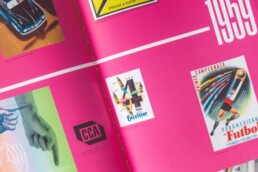Brand Storytelling that Propels Consumer Journeys Forward
In the big picture of activating an elite consumer engagement strategy, rolling with the punches of behavioral implications continues to be a decisive launch point.
The concept of “user personas” is not fluff. It’s not just catchy buzz lingo. Rather, the user persona is a blueprint for re-imagining the approach to interaction. It’s an idea that has sparked enormous intrigue as an opportunity for brands to exceed expectations in the eyes of consumers.
In essence, today’s audiences resemble an assortment of unique profiles that directly affect the ways in which steady doses of content are absorbed. Modern consumers have proven to embody an interesting range of characteristics – anywhere from practical to skeptical – that ignite the ways in which information is processed. And thus, ‘personalizing’ a brand experience has become a scorching-hot topic. Rightfully so.
Where there’s smoke, there’s fire.
Statistics show that complete brand experience looms large, not only for consumer engagement but also for retention. This theory is accentuated by trends suggesting that, while modern consumers are displaying volatile tendencies, almost 3 in 4 will point to the “experience” as a deciding factor in purchasing decisions (based on data obtained from PwC’s “Future of Customer Experience” report released earlier this year). According to the same report, 65% of U.S. customers find a positive experience with a brand to be more influential than great advertising. A rewarding brand experience is irreplaceable, while a lackluster brand experience can be equally as catastrophic.
Earning a reaction from casual website visitors with meaningful, purpose-driven content is always a step in the right direction, at least in terms of building rapport with consumers on a journey that should inform and also inspire. Sometimes this content is flashy, sometimes it’s subtle. Either way, pushing the buttons of user personas and capitalizing on storytelling narratives sets the stage for a memorable brand experience.
Here are four brands, across four entirely separate categories, that personify the art of storytelling with a brush of creativity and a splash of ingenuity.
Beats by Dre
How rare is it when a creative duo can swing for the fences on two separate enterprise ventures, and succeed mightily on both occasions?
Rare, indeed. Although Jimmy Iovine and Andre “Dr. Dre” Young makes it seem like a piece of cake.
“The Defiant Ones” carved out formidable identities as stakeholders and visionaries of music label Interscope Records (Iovine as a co-founder in 1990, and Dre as an artist soon after), and the commercial acclaim was resounding. With signature brand elements featuring a bold ‘i’ logo and a polarizing “us against the world” rock star mentality, Interscope quickly became synonymous with iconic – setting the stage for a tangible realization of true audio innovation. This aura of invincibility took on a life of its own in 2006 when Iovine and Dre catapulted years of Interscope buzz into the launch of headphones manufacturer Beats by Dre (later acquired by Apple for billions in 2014).
Both Iovine and Dre remain a force to be reckoned with as patriarchs of an empire that hasn’t shown signs of slowing down. It wasn’t long before Beats was able to supplant competitors like Bose or JBL as the headphones of choice, primarily because the brand has always been a machine when it comes to strategic product placement and flavorful artist storytelling that can send shivers down the spines of music heads. The recipe for success has been long been defined by remarkable product representation in pop culture – mainly, through a deep index of influencers along with a focus on “lifestyle” segments that tie products into music videos in order to connect with younger generations.
With regards to total brand experience, Beats allows the Iovine and Dre Show to do the talking and amplify much of the noise surrounding the brand. Beats’ savvy approach to audience engagement translates on a website that synthesizes rich content strategy with larger-than-life product showcasing. Rebellious in voice, the site’s information architecture is broken down into three sections – Products, Support, and Stories. Beyond all the fine details of Beats product specifications, there’s an endless stream of colorful articles and memoirs/snippets that dive deeper behind the scenes into the role that Beats products are playing in the lives of its influencers (largely, musicians or athletes). Because of this, more context also exists on how Beats products are fueling cultural creativity.
With an illustrious personality and a timeless storytelling allure that speaks volumes, Beats continues to engineer its brand behind a philosophy that emphasizes people over product. Its narrative as a trendsetter among consumers continues to shine through, echoing as loudly and as brilliantly today as it did upon arrival into the marketplace. Moving forward, expect Beats and other Iovine-laced ventures to encapsulate pure entrepreneurship at its finest.
Airbnb
Perhaps no category or industry sector has dried up more as a result of 2020’s downward economic spiral than hospitality, which has been ravaged by a long-winded series of quarantines, travel restrictions, stay-at-home orders and a general (albeit, reasonable) fear or reluctance to travel. Seasonal spikes are channeling more fear, while all of the hospitality’s key performance indicators [such as occupancy and revenue per available room (RevPAR)] have already eclipsed new lows this year.
From a commerce perspective, however, brands entrenched in the space can’t afford to just stand still. Especially with a competitive edge – and a slice of the ‘market share’ pie – up-for-grabs with all brands playing the waiting game by the same rules. Desperate times call for creative measures, and Airbnb is a tremendous example of a hospitality brand that has weathered the storm with a re-imagined storytelling approach that has the ability to offset reduced click-throughs on its primary site.
This is evident through Airbnb.design, where the brand spices up its mission and promotes clarity about its goal of designing brand experience for a changing world.
The idea behind this subset of Airbnb as a whole lot more than just an online travel concierge is a magical spin. Visitors cruise on an adventure that spotlights Airbnb’s intent to interact with its global community through engineering & data science, sharing stories of the creative highs that result from users’ travel experiences happening on its platform. Jammed with insights via exclusive interviews from the company’s creative leaders, in addition to case studies about topics like photographing the world or building inclusive product (even overcoming “creative adversity”), Airbnb.design offers valuable context on shifting consumer needs and shows it has a pulse on the latest ups and downs in hospitality. It ends up being a consumer journey that, without a clear objective of booking a reservation, rubs off as less “tunnel vision”-ey and more eye-opening for the casual visitor.
New Era
Unlike hospitality, the streetwear fashion and lifestyle apparel categories are seeing somewhat of a resurgence without too many signs of taking a backseat. The popularity can be largely attributed to design as a catalyst, along with the category’s imaginative qualities from a creative standpoint. Also, according to McKinsey & Company’s annual “State of Fashion” report, that flow of momentum has much to do with “digital recalibration” and “inclusive culture” as pivotal themes shaping the category’s renaissance.
Celebrating its 100th year in 2020, Buffalo, NY-based New Era continues to stand out as a legacy brand in lifestyle apparel with a knack for breathtaking storytelling snapshots around moments of self-expression.
Apparel, and sportswear in particular, is an exciting category in which there’s literally something for everyone. Fans of teams, fans of players, fans of exclusive collections or unique collaborations – unite. And New Era brings that universal energy to life.
Within the framework of its user experience, New Era aligns the “product” with a palpable blend of sharp photography and a clean navigation structure that carefully defines its wide spectrum of audiences. Collections and collaborations can be sorted and filtered at the user’s discretion, complemented by eclectic imagery that almost jumps out of the screen. In turn, the visuals speak to the eccentricity and diversity in every thread. On the heels of several notable licensing partnerships and an ambassador series that drives affinity, New Era can also piece together a dynamic content strategy that keeps rolling season by season (to the tune of 1.2 million Instagram followers today).
If brand storytelling is a balancing act between pronounced user experience, well-rounded product offerings and striking content strategy – then consider New Era to be locked in.
Headspace
As “mindfulness” keeps soaring as a culturally relevant theme, Headspace is a brand that continues its ascent as a champion of human well-being. It’s difficult to think about a brand philosophy that could be more applicable to a laundry list of user personas that exist.
Highlighted by a mantra be kind to your mind, Headspace has a way of immersing users with an inviting, inclusive personality that encourages participation but doesn’t force it.
Immediately upon landing on the homepage, users have the option to ‘Start a Journey’ with a free trial or a quick introductory video clip explaining the brand’s mission. Users then gravitate towards fascinating articles and quick-hit FAQs on topics like meditation, sleep and stress as food for thought that’s quite palatable for casual visitors with time to browse. It makes sense that Headspace is now tapping into the music space, having synced up with John Legend to serve as its “Chief Music Officer” and help curate playlists for every type of meditative or concentrative moment. In a pinch, an extra dimension of relatability to the brand experience emerges.
As an advocate for self-care, Headspace promotes a healthy state of mind with a charming storytelling approach that’s thoughtful. Contemplative empowerment has never been friendlier.
Despite the variance in brands trying to achieve rejuvenation, the common denominator across categories can be an application of storytelling principles that accelerate brand identity, product strategy, or even both.
User personas represent the equivalent of a complex puzzle consisting of an infinite amount of pieces to solve. User personas represent a knot requiring several layers of analysis, along with courageous trial-and-error, to untangle. Half the battle for brands is authentic storytelling, and that’s exactly why an approach factoring in user personas can’t be erased from the marketing equation. Easily a marathon and not a sprint.
Transformational user experience is a byproduct of conversational design, where a casual website visitor can ride effortlessly on the wave of brand storytelling. While user personas can be so much a leap of faith, they set the tone for a more informed engagement strategy. Plausible efforts to resonate with consumers often begin with targeting user personas and leveraging brand storytelling as an ace-in-the-hole interactive technique.
The world is yours, as they say.
Next Item
Inside a Global UX Design Agency

Understanding Design Thinking and User-Centered Design
In the dynamic world of design and development, two methodologies stand out for their impact and effectiveness: Design Thinking and User-Centered Design (UCD). These approaches, while distinct, share a common goal of solving problems and enhancing…
The Power of Unified Design Language
Design language is the distinct style and approach that characterizes the visual and interactive elements of a product, brand, or system. It encompasses aspects such as typography, color schemes, and shapes, blending these elements to create a…
Design Language System: The Role, Build and Implementation
A Design Language System comprises multiple interconnected parts, including visual design principles, user interface components, interaction patterns, and UX guidelines. Building a Design Language requires careful planning, iterative designing, and…


